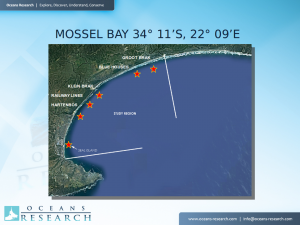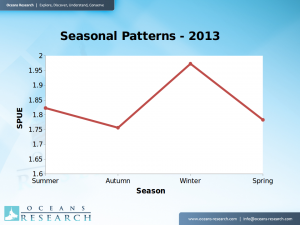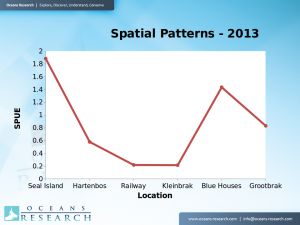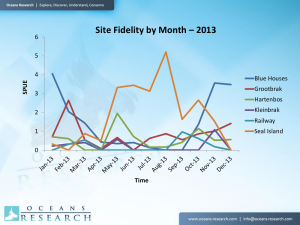Research with Bite: Project Great White Shark in 2013
Posted by Lauren Peel on April 29, 2014
It was another exciting year in 2013 at Oceans Research for Project Great White Shark where research continues in the beautiful Mossel Bay.
As we approach the exciting months of winter a.k.a “breaching season”, it seemed the perfect time to reflect on the past year of research and what our staff and interns have observed so far in 2014.
The aim of Project White Shark is to identify the spatial patterns in relative abundance, and investigate the size composition to define the population structure for white sharks in Mossel Bay. Oceans Research also aims to establish an index of abundance for white sharks in this area to better our estimates for their global population size. In simpler terms, we want to know how many sharks are in the bay at different times of the year, what areas they are concentrated in, what sizes are found in the different areas across seasons, and also, if individuals are staying in the bay year-round or moving away for months – even years – at a time.
In 2013, Oceans Research interns collected data for Project Great White Shark across 314 sampling trips to the various sites in Mossel Bay (34˚ 11’ S, 22˚ 09’ E; Image 1) totalling a massive 782 hours of sampling effort! Each trip averaged 2 hours and 49 minutes of sampling and with a total of 1,547 recorded white shark sightings, each trip averaged 1.96 shark sightings per hour (sharks per unit effort; SPUE).
The below graph (Image 2) represents the average number of sharks observed per unit effort (hour; SPUE) across each of the four seasons in 2013, with the winter months corresponding to the highest value of 1.97 SPUE. In comparison to the average SPUE of 1.83, this peak in the winter months is correlated to the movement of white sharks to Seal Island (approximately 800 metres from shore) where the Cape Fur seal pups begin to enter the water for the first time since their birth in November/December. The lack of experience of these seal pups in identifying and avoiding strikes from their large predators makes them easy targets in their new aquatic environment during this time of year, thus providing the perfect feeding opportunity for the larger marine-mammal consuming sharks in Mossel Bay.
White sharks ranging from 125 – 474 cm total length were observed in 2013, with just under 75% of recorded individuals being placed in the 175 – 324 size range. Larger sharks (325 – 474 cm total length) comprised 17% of the recorded individuals, with sharks ranging from 125 – 174 cm total length making up the last 9% of observed white sharks for the year. Already in 2014, two of these larger individuals have already been sighted with total lengths estimated to be 470 and 500 cm! It will be very interesting to see if these sharks hang around until later in the year!
In terms of white shark activity for 2013, Seal Island and Blue Houses sites were observed to be the focal areas (areas of highest activity) in the seasons of winter and summer respectively in Mossel Bay. Image 3 presents the average SPUE observed across all of our study sites for 2013, and illustrates the higher SPUE for Seal Island (1.88) and Blue Houses (1.43) in comparison to the average of 0.86 SPUE and this pattern has been observed for the last few years. The peak SPUE value at Seal Island is a result of the previously discussed movement of white sharks to the area for winter’s ‘breaching season’, as the young seal pups of the year enter the water for the first time and provide easy high-energy prey targets. The high SPUE witnessed at Blue Houses is correlated with this site being the focal area for white shark activity in the summer months.
A lack of inexperienced seal pups entering the water in summer in comparison to in the early winter months drives the white sharks to move across the bay to the reef systems of the Grootbrak area - the Blue Houses site in particular - to utilise the fish stocks that reside there. The river systems and mouths located between these two focal sites (Hartenbos, Kleinbrak, and Grootbrak rivers) provide resting areas for the sharks between hunting trips, which is a potential reason why we see less sharks in these areas as they could be less attracted to our baits due to the fact that they might have already hunted and fed. The dynamic nature of the white shark population across the sampling sites for Oceans Research in Mossel Bay is illustrated in Image 4 below, which shows how SPUE vales for each of the locations changes throughout the year. The movement of Mossel Bay’s white sharks from Blue Houses to Seal Island and back as winter comes and passes can also be seen below.
In previous years of this study (2013 included), the movement of white sharks from Blue Houses to Seal Island has been observed to occur around the end of March – early April however, in 2014 this movement was noted to have occurred in early March. The precise reason for this early movement is not currently known but possible explanations include changing fish stock supplies and varying environmental cues.
Another interesting observation made by Oceans Research across the summer of 2013 and 2014 was the predominance of “red-tide” algal blooms that entered the bay quite frequently; some days reducing the visibility in the water to less than one metre! It is unknown what is driving these intense algal blooms and which species of algae are causing this problem, however we have seen that these events have the potential to reduce the number of shark sightings made on sampling trips (even in focal areas).
As well as heading out into the field to conduct research for Project Great White Shark, Oceans Research also aims to educate and involve the community in our research. Numerous meetings have been held with the surfing community of Mossel Bay since the beginning of 2014 to explain how we execute our research and discuss the highly contentious issue of chumming. These meetings aim to explain to the public the science behind why we chum, and the minimal to negligible impact our methods and protocols pose to shark behaviour and water-user safety. It also provides the perfect opportunity for people to ask questions or raise concerns directly to the staff of oceans, and even to make suggestions about how we can improve how we communicate our research and actions to the public. A great example of how communications between Oceans Research and the public is increasing is the initiation of a “chumming flag” system during research trips to study the white sharks. When chumming on these trips, a white flag with a black profile of a shark (Image 5) is flown from the research vessel so that it can clearly be seen from land. This allows people on the beach to know if our vessel is chumming or not (in the latter case, this means that research is being carried out for other projects in the bay).
It’s been an exciting year so far on the waters of Mossel Bay in early 2014 for Project Great White Shark, and with breaching season just around the corner, everyone is very excited because....
...WINTER IS COMING



